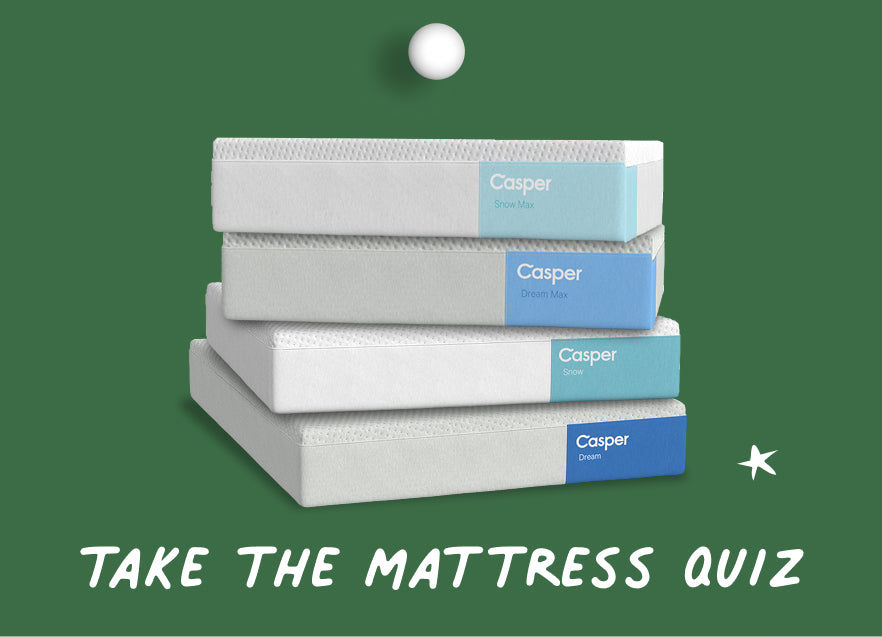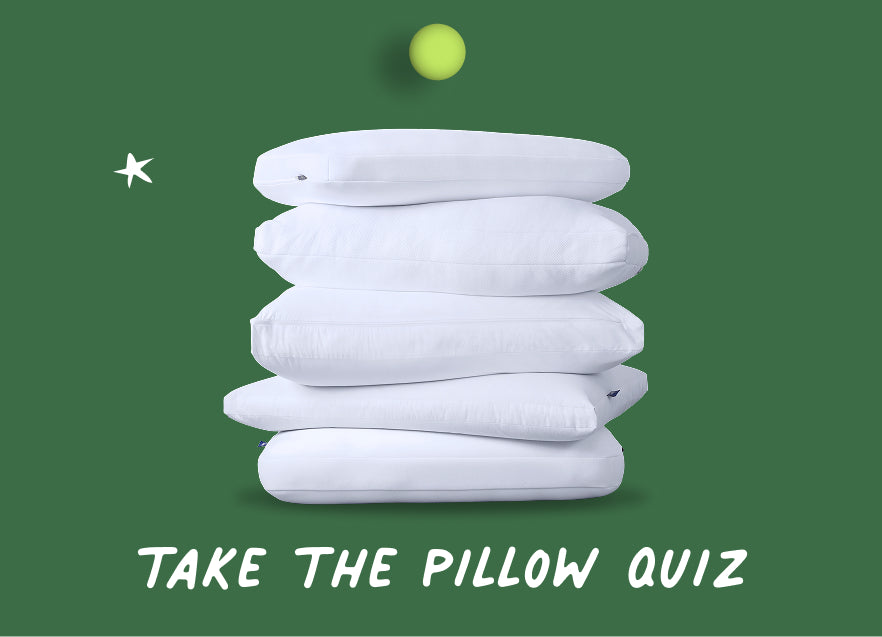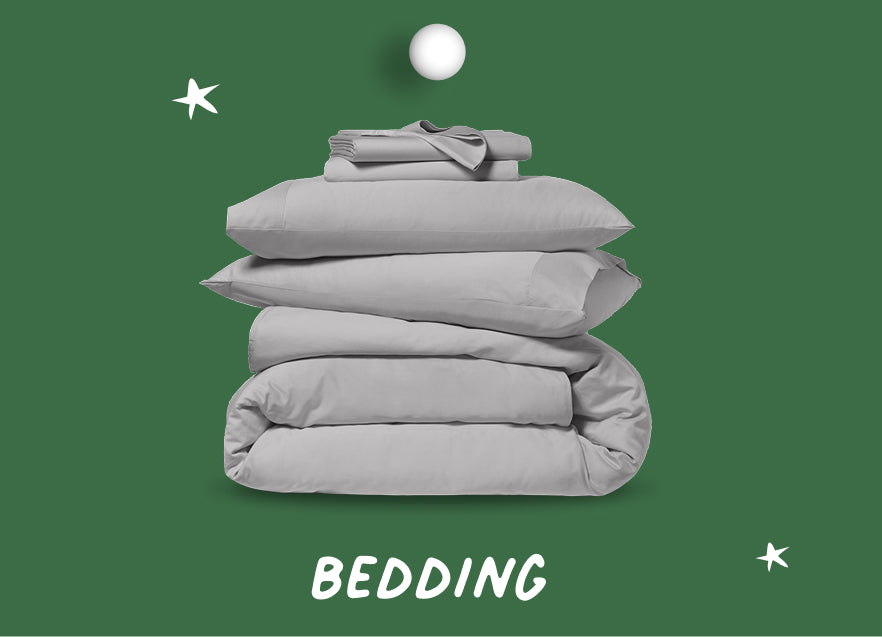Updated Nov 10, 2025
A hybrid mattress combines the support of innerspring coils with substantial foam (or latex) comfort layers, while a traditional innerspring mattress relies mainly on coils for support with less cushioning.
In researching different types of mattresses, you’ve come across hybrid mattresses and innerspring. But what’s the difference between a hybrid vs innerspring mattress?
While hybrid and innerspring mattresses both share a coil system for the base, hybrid mattresses combine layers of foam for comfort whereas innerspring mattresses have a thin layer of cushioned material. Innerspring mattresses tend to be a firmer mattress compared to hybrids because of their internal coil structure, however, are not necessarily more supportive.
In fact, it’s quite the contrary: hybrid mattresses, which combine innersprings’ architecture with plush mattress layers give sleepers dreamy levels of comfort that are both supportive and snuggle-worthy.
Here, we’ll examine how each mattress type functions, and help you decide which is the right fit for you.
What is a Hybrid Mattress?
So, what is a hybrid mattress exactly? Most non-wire mattresses today may exclusively use memory foam, latex foam, or gel foam to give their mattresses cozy comfort.
Hybrid mattresses, on the other hand, fuse the veteran ergonomics of innerspring mattresses with the plushness of modern wireless mattress design. They’re engineered to offer the stability of innerspring mattresses, without compromising on comfort with:
- Foundation layer – Unlike innerspring mattresses, hybrid mattresses do not require a box spring for back support. Instead, their foundational layer consists of two or so inches of padding for stability and comfort.
- Core layer – This section constitutes the bulk of a hybrid mattress, and is typically seven to eight inches thick. It combines the structure, lift, and airflow of coil wreaths with foam’s supple and figure-hugging hold.
- Comfort layer – The most sensible layer of your mattress, the comfort layer sits just beneath your body while you sleep. Hybrid mattresses may use memory foam, latex, or cooling gel to modulate the sleeper’s experience from the top down. Typically, they just use a foam comfort layer.
Pros of Hybrid Mattresses
So, are hybrid mattresses good? By combining the stability of an innerspring mattress and the pliability of a foam mattress, hybrid mattresses are more readily adaptable to many different kinds of lifestyles and comfort levels than the traditional mattress model. They’re especially advantageous for the following reasons:
- Adaptable support – Regardless of your preferred sleeping position, whether you’re a side sleeper, back sleeper, or stomach sleeper, the foam layers contour to your body while coils keep your spine aligned.
- Great for couples – Pocketed coils help minimize motion transfer, supporting different couples sleeping positions. This way, partners with different sleep styles can rest soundly without disturbing each other.
- Breathable design – Airflow through the coil base helps regulate temperature, keeping the bed cooler than all-foam options.
- No box spring needed – Hybrids work well on slatted frames, platform beds, or adjustable bases, giving you plenty of setup flexibility.
- Durability and value – With both coils and foam in play, hybrids are built to last longer than some all-foam models—making them a smart investment over time.
Cons of Hybrid Mattresses
Even the best hybrids come with trade-offs. Here are a few things to keep in mind before you buy:
- Heavier to move – With multiple layers of foam and coils, hybrids can be bulkier and harder to shift than simpler designs.
- Higher price point – Quality hybrids often cost more upfront than basic innersprings or all-foam mattresses.
- Too much of a mix for some – Sleepers who prefer the consistent feel of a single-material mattress may not love the blended experience.
- Variable performance – Not all hybrids are created equal; factors like coil type, foam density, and thickness can make a big difference in comfort and support.
The versatility and structural nuance of hybrid mattresses may mean that they come with a higher price tag, but their durability and longer lifespan may save sleepers money in the long run.
What is an Innerspring Mattress?
Innerspring mattresses have been around since the mid-19th century when upholstery coil springs were first used in the construction of carriage seats of the original horse-powered vehicle—the horse and buggy. They have been the traditional mattress that most people are familiar with.
Since then, four main kinds of coils have been developed:
- Bonnell coils
- Pocket coils
- Offset coils
- Continuous coils
Each variety of coil has a unique ability to respond to added weight and pressure, but all innerspring coil technology has one paramount purpose: to provide full-body support while you’re sleeping.
While innersprings provide the mattress’ foundation—the scaffolding—two additional layers are added to the mix to make the mattress comfortable for sleep:
- Foundation layer – This layer is found below the core structure and is known as the box spring. The box spring’s pattern hews to the coil pattern of your innerspring mattress, fortifying the overall structure and enhancing overall shock absorption.
- Comfort layer – This is the mantle of an innerspring mattress, which upholsters the surface to make it plush and comfortable for any sleep position.
In combination with the two layers, the coils in an innerspring mattress’ core layer allow more air to flow through the body of the mattress, which may provide relief for people who are prone to overheating in bed.
Pros of Innerspring Mattresses
Innerspring mattresses are the classic choice—built with steel coils at the core for a firmer, more traditional feel. Here are some reasons people still love them:
- Budget-friendly – Innersprings are typically less expensive than hybrids, making them a go-to option for shoppers seeking affordability.
- Responsive bounce – Coils give that springy, on-the-bed feel that some sleepers prefer.
- Cooling potential – The open coil structure allows for more airflow than solid foam beds, which can help hot sleepers stay comfortable.
- Variety of firmness levels – Factors like coil gauge, height, and pattern can create a wide range of firmness options.
Cons of Innerspring Mattresses
While innersprings have staying power, they do come with trade-offs worth considering:
- Less pressure relief – Without the plush foam layers hybrids offer, innersprings may not contour as well to the body.
- Box spring required – Most innersprings need a box spring or foundation to maintain proper support and prevent sagging.
- Shorter lifespan – Springs can lose tension and wear unevenly over time, which often shortens durability compared to hybrids.
- More motion transfer – Unless pocketed coils are used, innersprings can transfer movement more easily, making them less ideal for couples.
- Maintenance needed – To avoid dips and uneven wear, many innersprings need to be flipped or rotated regularly.
Core Differences Between Hybrid and Innerspring Mattresses
The main factor in the innerspring vs hybrid mattress debate is that while the former exclusively uses coil technology to provide structure, the latter combines both coil and other ergonomic interventions to construct the body of the mattress.
Hybrid mattresses are designed to meet the needs of different kinds of sleepers, and their versatility enables engineers to take more liberties within the realm of mattress design.
Comfort
While comfort layers in innerspring mattresses are sparse, hybrid mattresses have the latitude to lay them on thick. The Casper Dream mattress, for instance, “zones” its topmost layers of foam to provide proper support through the night.
Spinal Alignment
The stiff support of a traditional innerspring mattress can provide sleepers with lower back pain some relief. However, hybrid mattresses are both supportive and responsive, providing structural and comfortable support.
Some hybrid mattresses, such as the Dream Max orthopedic mattress, are specifically designed to provide relief for your body. It combines pressure-relieving foams with supportive springs to enhance spinal alignment and alleviate aches and pains. Its medium-soft firmness level offers a responsive and lively feel, making it suitable for sleepers with aches and pains, side sleepers, and those who share a bed.
Thermoregulation
Studies conclude that the optimal temperatures for adults to get quality shut-eye range between 60 and 72 degrees Fahrenheit. But no matter how hawkish you are about your thermostat, your bed is a microclimate all its own—and the type of mattress you choose can be the difference between sweat-stained sheets and sleeping bliss.
The coiled structure of innerspring mattresses allows for ample air flow that can cool sleepers throughout the night. However, hybrid mattresses do that, and then some.
Hybrid mattresses like the Snow use perforations on the surface of the foam as entry and exit portals that circulate air and body heat during the wee hours. The hybrid style also allows for functional additions, like HeatDelete™ bands, which dissipate heat for up to 12 hours.
In this way, shape-conforming materials like traditional memory foam don’t have to compromise on adequate ventilation.
Motion Isolation
If you share a bed with a partner (or a furry friend that roams around at 2 a.m.), motion isolation can be a deal-breaker when choosing a mattress. Innerspring mattresses have a bounce, so you might feel a partner’s movement more easily. Memory foam mattresses provide better motion isolation compared to traditional beds. Hybrid mattresses leverage their foam layers to absorb motion before it ripples across the bed, ensuring minimal disturbance. That way, your late-night bathroom trips (or your cat’s tap-dance routine) won’t disrupt your sweet slumber.
Edge Support
Ever sit on the edge of your bed to put on your socks? Or rest a laptop on the side while you watch your favorite show? That’s where edge support comes in. Generally, innerspring mattresses provide sturdy edges thanks to their reinforced coil systems, but hybrids are no slouch either—many integrate additional foam encasements around the perimeter. With firm edge support, you’ll feel secure whether you’re perched at the corner or sprawling out for an afternoon nap.
Should I Choose Hybrid or Innerspring?
If you’re wondering how to choose a mattress and are weighing your options between innerspring and hybrids, these are the main points of consideration to take into account:
- Comfort – While innerspring mattresses tend to become more forgiving with time, this tends to be a sign of degradation or spring damage, rather than built-in softness. If you are experiencing this type of degradation, it’s a common sign you need a new mattress. Contrarily, there’s no need to break in a hybrid mattress—softness is elemental to the design, throughout every layer.
- Quality – Innerspring mattresses have a storied heritage, and there are undoubtedly some high-quality innerspring mattresses on the market. Nevertheless, to maintain its performance over time you will need to perform some routine mattress rotating and flipping to ensure your mattress springs keep their bounce.
- Budget – Innerspring mattresses tend to be less expensive overall, and can be a great option if you’re not set on staying in your current place of residence. While they aren’t as supportive as hybrids when it comes to sleep hygiene, you can cushion your sleep experience by purchasing a suitable mattress topper for a boost of comfort.
Overall, hybrid mattresses tend to be comfier and more supportive than innerspring mattresses. When deliberating between a hybrid mattress vs innerspring mattress, your verdict may come down to budget and whether you’re ready to invest in your sleep hygiene and the overall well-being it supports.
For the Best of Both Worlds, Nod Off with Casper
Whatever your lifestyle, or your sleep style, choosing a Casper mattress will always be an upgrade.
Casper’s engineers have created four hybrid mattresses to choose from:
Each mattress type was designed to provide two non-negotiables for the body at rest: stability and comfort. Ready to take the plunge into a comfortable hybrid bed? Shop our hybrid mattresses and compare hybrid vs memory foam and other popular mattress types today.
FAQs About Innerspring vs Hybrid Mattresses
How high of a coil count is good for an innerspring vs hybrid mattress?
Target 600–1,000 coils for a queen-size innerspring or hybrid, with higher counts (up to 1,200) further improving support—especially if matched with good coil construction and quality. Look for the balance between coil count and material quality rather than just numbers.
Why is a hybrid more expensive than innerspring?
Hybrids use more layers and premium materials—coils plus foam—making them more durable and comfortable, but also typically pricier than simpler innersprings.
Can I flip a hybrid mattress?
You should not flip a hybrid mattress, as most modern hybrid mattresses are single-sided and designed with distinct layers that function only in one orientation: a comfort layer on top and a support core below. Flipping a hybrid mattress would put you directly on the firmer support layer, which is not suited for sleeping and could cause discomfort and permanent damage to the mattress structure. Instead, rotate your mattress every few months to help it wear evenly.
Sources:
- The Mattress Underground. Mattress Support Cores – Innersprings. https://www.themattressunderground.com/mattresses/support-cores/innersprings/#bonnell-coils
- Sleep Advisor. What’s the Best Temperature for Sleep? https://www.sleepadvisor.org/best-temperature-for-sleep/









